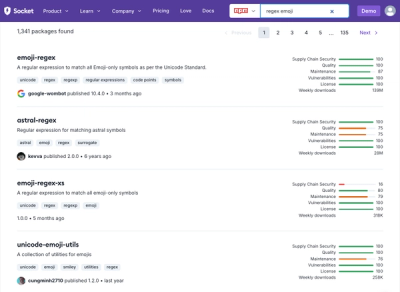
Security News
Weekly Downloads Now Available in npm Package Search Results
Socket's package search now displays weekly downloads for npm packages, helping developers quickly assess popularity and make more informed decisions.
@bentoproject/date-display
Advanced tools
Displays time data that you can render in your page.
Displays time data that you can render in your page. By providing specific attributes in the Bento Date Display tag, the Bento Date Display extension returns a list of time parameters, which you can pass to an amp-mustache template for rendering. Refer to the list below for each returned time parameter.
You must include each Bento component's required CSS library to guarantee proper loading and before adding custom styles. Or use the light-weight pre-upgrade styles available inline. See Layout and style.
Install via npm:
npm install @bentoproject/bento-date-display
import {defineElement as defineBentoDateDisplay} from '@bentoproject/bento-date-display';
defineBentoDateDisplay();
<script><script type="module" src="https://cdn.ampproject.org/bento.mjs" crossorigin="anonymous"></script>
<script nomodule src="https://cdn.ampproject.org/bento.js" crossorigin="anonymous"></script>
<!-- Include bento-mustache.js to use mustache templates with this component -->
<script async src="https://cdn.ampproject.org/v0/bento-mustache.js"></script>
<script type="module" src="https://cdn.ampproject.org/v0/bento-date-display-1.0.mjs" crossorigin="anonymous"></script>
<script nomodule src="https://cdn.ampproject.org/v0/bento-date-display-1.0.js" crossorigin="anonymous"></script>
<link rel="stylesheet" href="https://cdn.ampproject.org/v0/bento-date-display-1.0.css" crossorigin="anonymous">
<!DOCTYPE html>
<html>
<head>
<script
type="module"
async
src="https://cdn.ampproject.org/bento.mjs"
></script>
<script nomodule src="https://cdn.ampproject.org/bento.js"></script>
<script async src="https://cdn.ampproject.org/v0/bento-mustache.js"></script>
<script
type="module"
async
src="https://cdn.ampproject.org/v0/bento-date-display-1.0.mjs"
></script>
<script
nomodule
async
src="https://cdn.ampproject.org/v0/bento-date-display-1.0.js"
></script>
<link
rel="stylesheet"
type="text/css"
href="https://cdn.ampproject.org/v0/bento-date-display-1.0.css"
/>
</head>
<body>
<bento-date-display
datetime="2021-09-09T16:02:08.494Z"
displayIn="utc"
locale="en-GB"
>
<template>
<div>ISO: {{iso}}; locale: {{localeString}}</div>
</template>
</bento-date-display>
</body>
</html>
The Bento Date Display component does not have an imperative API. However, the Bento Date Display Web Component will render a mustache-template, provided by the consumer in a <template> tag with type="amp-mustache". This template may interpolate date-related parameters. See the Returned Time Parameters section for a full list of all the available parameters.
Each Bento component has a small CSS library you must include to guarantee proper loading without content shifts. Because of order-based specificity, you must manually ensure that stylesheets are included before any custom styles.
<link rel="stylesheet" type="text/css" href="https://cdn.ampproject.org/v0/bento-date-display-1.0.css">
Alternatively, you may also make the light-weight pre-upgrade styles available inline:
<style data-bento-boilerplate>
bento-date-display {
display: block;
overflow: hidden;
position: relative;
}
</style>
datetimeThe datetime attribute specifies the date and time in a standard ISO 8601 date
string (e.g. 2017-08-02T15:05:05.000Z) or the string now. If set to now,
bento-date-display will use the time the page loaded to render its template.
timestamp-msThe timestamp-ms attribute specifies the date and time using the number of
milliseconds since 1970-01-01T0:00:00.000Z
timestamp-secondsThe timestamp-seconds attribute specifies the date and time using the number
of seconds since 1970-01-01T0:00:00.000Z
locale (optional)An internationalization language string for each timer unit. The default value
is en (for English). This attribute supports all values that are supported by
the user's browser.
display-in (optional)If set to the value utc, the display-in attribute will convert the given
date to UTC.
offset-seconds (optional)The offset-seconds attribute specifies an integer number of seconds to shift
the given date.
data-options-\* (optional)The data-options-* supports all the options under Intl.DateTimeFormat.options
parameter that specifies the formatting style to use for localeString format.
Valid attributes include: data-options-date-style, data-options-time-style, etc.
Note that if display-in attrubute is set to utc, the value of
data-options-time-zone will automatically be converted to UTC.
You may use the bento-date-display element selector to style the Bento Date Display component freely.
npm install @bentoproject/date-display
import React from 'react';
import {BentoDateDisplay} from '@bentoproject/date-display/react';
import '@bentoproject/date-display/styles.css';
function App() {
return (
<BentoDateDisplay
datetime={dateTime}
displayIn={displayIn}
locale={locale}
render={(date) => (
<div>{`ISO: ${date.iso}; locale: ${date.localeString}`}</div>
)}
/>
);
}
The Bento Date Display component does not have an imperative API. However, the Bento Date Display Preact/React component does accept a render prop that renders the consumer's template. This render prop should be a function which the Bento Date Display Preact/React component can use to render its template. The render callback will be provided a variety of date-related parameters for consumers to interpolate in the rendered template. See the render prop section for more information.
The Bento Date Display Preact/React component allows consumers to render their own templates. These templates may use inline styles, <style> tags, Preact/React components that import their own stylesheets.
datetimeRequired prop. Denotes the date and time as a Date, String, or Number. If String, must be a standard ISO 8601 date string (e.g. 2017-08-02T15:05:05.000Z) or the string now. If set to now, it will use the time the page loaded to render its template. If Number, must be a POSIX epoch value in milliseconds.
displayInOptional prop that can be either "utc" or "local" and defaults to "local". This prop indicates what timezone to display the date in. If set to the value "utc", the component will convert the given date to UTC.
localeAn internationalization language string for each timer unit. The default value is en (for English). This prop supports all values that are supported by the user's browser.
localeOptionsThe localeOptions object supports all the options under Intl.DateTimeFormat.options parameter that specifies the formatting style to use for localeString format.
Note that if the displayIn prop is set to utc, the value of localeOptions.timeZone will automatically be converted to UTC.
renderOptional callback that should render a template. The callback will be provided an object with properties/values related to the date expressed in datetime.
By default, the Bento Date Display component will display the localeString form of the Date for the given locale and localeOption. See the Returned Time Parameters section for more details on how each property will be displayed.
(dateParams: DateParams) => JSXInternal.Element
interface DateParams {
day: number;
dayName: string;
dayNameShort: string;
dayPeriod: string;
dayTwoDigit: string;
hour: number;
hour12: number;
hour12TwoDigit: string;
hourTwoDigit: string;
iso: string;
localeString: string;
minute: number;
minuteTwoDigit: string;
month: number;
monthName: string;
monthNameShort: string;
monthTwoDigit: string;
second: number;
secondTwoDigit: string;
timeZoneName: string;
timeZoneNameShort: string;
year: number;
yearTwoDi: string;
}
This table lists the format you can specify in your Mustache template:
| Format | Meaning |
|---|---|
| day | 1, 2, ...12, 13, etc. |
| dayName | string, |
| dayNameShort | string, |
| dayPeriod | string, |
| dayTwoDigit | 01, 02, 03, ..., 12, 13, etc. |
| hour | 0, 1, 2, 3, ..., 12, 13, ..., 22, 23 |
| hour12 | 1, 2, 3, ..., 12, 1, 2, ..., 11, 12 |
| hour12TwoDigit | 01, 02, ..., 12, 01, 02, ..., 11, 12 |
| hourTwoDigit | 00, 01, 02, ..., 12, 13, ..., 22, 23 |
| iso | A standard ISO8601 date string e.g. 2019-01-23T15:31:21.213Z, |
| localeString | A string with a language sensitive representation. |
| minute | 0, 1, 2, ..., 58, 59 |
| minuteTwoDigit | 00, 01, 02, ..., 58, 59 |
| month | 1, 2, 3, ..., 12 |
| monthName | Internationalized month name string. |
| monthNameShort | Internationalized abbreviated month name string., |
| monthTwoDigit | 01, 02, ..., 11, 12 |
| second | 0, 1, 2, ..., 58, 59 |
| secondTwoDigit | 00, 01, 02, ..., 58, 59 |
| timeZoneName | Internationalized timezone, like Pacific Daylight Time |
| timeZoneNameShort | Internationalized timezone, abbreviated, like PST |
| year | 0, 1, 2, ..., 1999, 2000, 2001, etc. |
| yearTwoDigit | 00, 01, 02, ..., 17, 18, 19, ..., 98, 99 |
FAQs
Displays time data that you can render in your page.
The npm package @bentoproject/date-display receives a total of 4 weekly downloads. As such, @bentoproject/date-display popularity was classified as not popular.
We found that @bentoproject/date-display demonstrated a not healthy version release cadence and project activity because the last version was released a year ago. It has 3 open source maintainers collaborating on the project.
Did you know?

Socket for GitHub automatically highlights issues in each pull request and monitors the health of all your open source dependencies. Discover the contents of your packages and block harmful activity before you install or update your dependencies.

Security News
Socket's package search now displays weekly downloads for npm packages, helping developers quickly assess popularity and make more informed decisions.

Security News
A Stanford study reveals 9.5% of engineers contribute almost nothing, costing tech $90B annually, with remote work fueling the rise of "ghost engineers."

Research
Security News
Socket’s threat research team has detected six malicious npm packages typosquatting popular libraries to insert SSH backdoors.